This is an archived article that was published on sltrib.com in 2016, and information in the article may be outdated. It is provided only for personal research purposes and may not be reprinted.
As the hiking and camping season opens, the Unified Police Department and Salt Lake City Department of Public Utilities Watershed Management hope that reminding people about the state's watershed laws will result in fewer citations than in past years.
Protected watershed areas in the Salt Lake County area include East Canyon, City Creek, Parleys, Dell and Lambs canyons (north and east of Mt. Dell Reservoir), and Big and Little Cottonwood canyons.
"A watershed is a geographical or geological area of land that catches the rain and snow drained by a single river system," according to a UPD news release. "If a drop of rain lands near a ridgeline, it will eventually flow to the stream at the bottom of the canyon. All surface and ground water that contributes to a stream is a part of that watershed system"
The state's watershed regulations — listed in descending order of those most often violated — are:
— Dogs: Dogs, horses, and domestic animals are prohibited in protected watershed areas because their waste can end up in your drinking water.
Exceptions: Residents can get permits and tags for dogs on their own property. ADA service dogs that are federally licensed, certified, and permitted (does not include comfort dogs unless federally certified and licensed). Search and Rescue Dogs that are certified and permitted.
— Camping: Camping is allowed in developed campgrounds. City Creek and Parleys canyons do not allow backcountry camping. In other areas, unless posted, backcountry camping is allowed a half mile from any road and 200 feet from any water source or trail.
Practice "Leave No Trace" skills. If you carry it in, carry it out, and leave nothing behind.
Fires are allowed in developed campgrounds only within the established rings. Backcountry campfires are allowed in most areas, unless otherwise posted as closed. Same rules for backcountry fires as camping, a half mile from any road, etc. Use of backpacking stoves instead of campfires in the backcountry is suggested. Seasonal restrictions on fire use may apply. Fireworks are prohibited.
— Swimming or wading: Swimming, wading and motorized boating are prohibited in protected watersheds. This includes Lake Mary in the Brighton area of Big Cottonwood Canyon. UPD officers have more violations of watershed regulations regarding swimming and wading at Lake Mary than all others combined. Obey the signs that are posted along the trails and around the lakes. Wading is only allowed if the person is fishing in lakes and streams and is wearing waders.
— Depositing Human Waste: Keep your drinking water supply clean by using restrooms. In the backcountry, users must bury their waste at least 6 inches deep and 200 feet from any water source or trail. Urinating is included in this regulation as well.
— Off-road Vehicles are Prohibited: ATVs, OHVs, etc. are not allowed in a watershed area. It is also unlawful to disrupt the soil in a watershed, which is usually caused by an off-road vehicle.
Anyone caught violating watershed regulations can be arrested under the Public Health and Sanitation laws pursuant to Utah Code Annotated 26A-1-123.
The first violation will be charged as a Class B misdemeanor. Normally, UPD patrol officers will issue first-time violators a citation. Typically, these have resulted in a $650 fine from the court.
A second or subsequent violation within two years will result in a Class A misdemeanor, which carries heavier penalties, including up to a year in jail.
UPD said the regulations are in effect year-round and are posted on large signs at the mouths of each canyon to educate and warn of the rules and consequences for violation.



